Top 10 Workflow Automation Tools for Scaling
Explore the top 10 workflow automation tools that enhance productivity and support business scaling through efficient task management.

Workflow automation tools save time by handling repetitive tasks, allowing businesses to focus on growth. Here are the top 10 tools for scaling:
- Zapier: Connects apps with "Zaps" for multi-step workflows. Offers extensive integrations and customization options.
- Make (formerly Integromat): Visual platform with over 1,400 app integrations. Handles bulk data and complex workflows.
- n8n: Open-source, self-hosted tool for privacy-focused automation. Supports custom integrations and advanced logic.
- Relay: Simple interface for non-technical users. Supports GPT-based automations and integrates with 100+ apps.
- Integrately: Pre-built "1-click" automations for quick setups. Affordable task-based pricing.
- IFTTT: Trigger-action platform for simple automations. Great for small businesses and personal use.
- FlowForma: No-code platform with AI-powered workflow creation. Ideal for industries like healthcare and construction.
- Automation Anywhere: Enterprise-level RPA solution for complex tasks, offering attended and unattended automation.
- Workato: Recipe-based system for scalable enterprise automation. Integrates cloud and on-premise systems.
- Windmill: Open-source platform for script-based workflows. Flexible deployment with self-hosting options.
Each tool offers unique features, from integrations to scalability. Choose based on your business size, technical expertise, and automation goals.
Quick Comparison:
| Tool | Best For | Pricing Model | Key Strengths |
|---|---|---|---|
| Zapier | Small to medium businesses | Free + Paid Plans | Multi-step workflows, app integrations |
| Make | Visual workflow creation | Operations-based | Bulk data handling, 1,400+ integrations |
| n8n | Privacy-focused automation | Free + Paid Plans | Open-source, self-hosted flexibility |
| Relay | Non-technical users | Free + Paid Plans | Simple UI, GPT-based automations |
| Integrately | Quick setups | Task-based | Pre-built templates, affordable plans |
| IFTTT | Simple tasks | Freemium | Trigger-action simplicity, IoT support |
| FlowForma | Industry-specific workflows | Subscription-based | No-code, AI-powered creation tools |
| Automation Anywhere | Enterprise automation | Usage-based | RPA, AI document processing |
| Workato | Enterprise integrations | Task-based | Recipe-based, hybrid integrations |
| Windmill | Developers & teams | Free + Paid Plans | Script-first, open-source flexibility |
Start small, test workflows, and expand as your business scales.
11 Best AI Workflow Automation Tools to 10X Your Productivity in 2025
1. Zapier
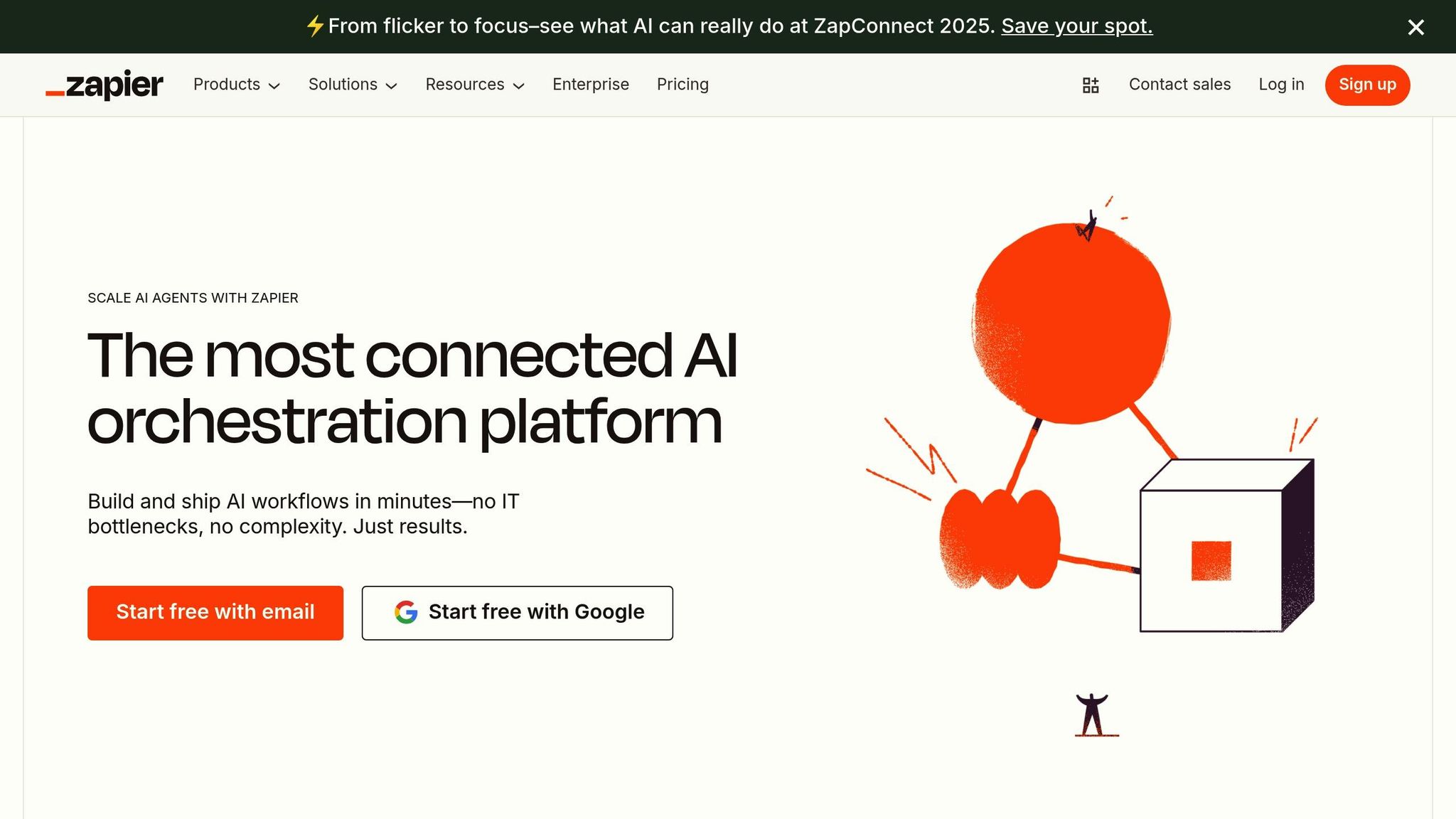
Zapier is a tool designed to automate workflows without needing advanced technical skills. It connects various apps and services using simple "Zaps", which are automated actions triggered by specific conditions.
Integration Capabilities with Other Tools
One of Zapier's standout features is its extensive library of app integrations. It supports popular tools like Salesforce and HubSpot for CRM needs, as well as communication platforms such as Slack and Microsoft Teams. This wide range of integrations allows you to connect many of the tools you already use in your daily operations.
Zapier is particularly effective at managing multi-step workflows. For example, you can set up a Zap that automatically creates a CRM record, sends a welcome email, and adds the contact to a mailing list - all without manual intervention. Additionally, it supports both cloud-based and on-premise applications through webhooks, making it versatile for different tech setups.
Scalability for Growing Businesses
Zapier's tiered pricing model and advanced features make it a great choice for businesses looking to scale. Multi-step Zaps allow for creating intricate workflows involving multiple apps and decision points. Built-in conditional logic ensures that automations can adapt to specific criteria, making workflows smarter and more efficient.
For teams, Zapier offers collaboration tools that let multiple users work together to create, manage, and monitor automations. This feature is especially useful for organizations aiming to streamline processes across departments.
Customization for Unique Workflows
Zapier provides numerous options to tailor workflows to specific needs. Features like Filters and Paths enable detailed decision trees, ensuring workflows align perfectly with your business requirements.
For those needing more advanced customization, the "Code by Zapier" feature allows you to embed custom JavaScript or Python code into workflows. This can be used for complex data manipulation or unique logic. Additionally, Formatter tools let you modify data - whether it's formatting dates, extracting specific details, or performing calculations - so it fits seamlessly into your target applications.
Pricing and Cost-Effectiveness
Zapier offers a free plan, making it an excellent starting point for small businesses and individuals looking to explore automation. For growing enterprises, its paid plans provide higher task limits and advanced features such as multi-step workflows and custom logic.
2. Make (formerly Integromat)
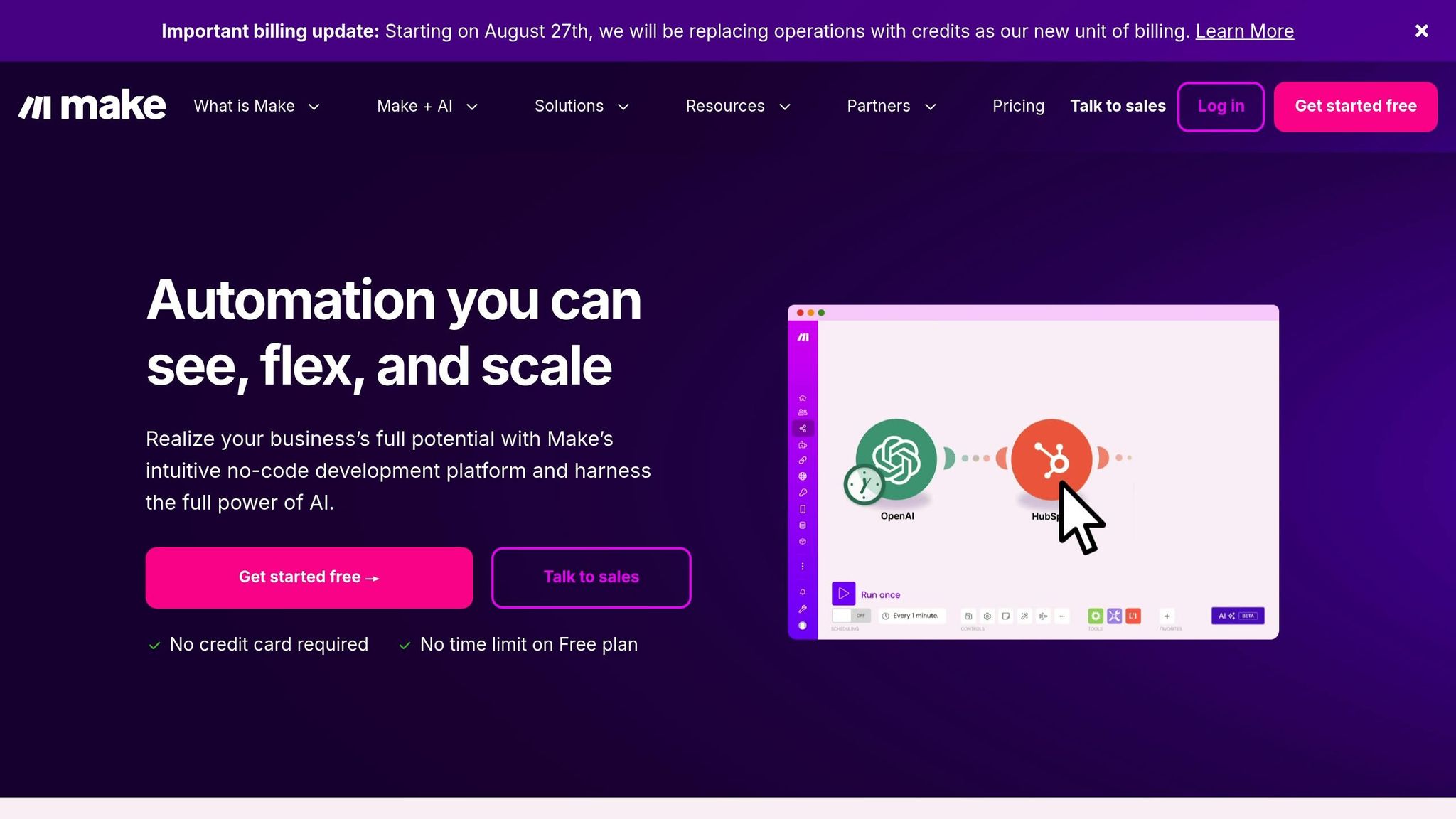
Make is a visual workflow automation platform that simplifies the process of connecting apps and automating tasks. It uses a scenario-based approach, presenting workflows as visual flowcharts, which makes even complex automation logic easier to grasp. Let’s dive into how Make’s integration options and customization tools can supercharge automation.
Integration Capabilities with Other Tools
Make connects with over 1,400 apps, including popular platforms like Google Workspace, Microsoft 365, Shopify, WordPress, and Airtable. It’s particularly effective at managing real-time data updates between systems, ensuring instant synchronization across platforms.
With HTTP modules and webhook triggers, you can integrate with virtually any API, enabling connections to custom applications and automating workflows based on specific triggers.
One standout feature is how Make processes data in bundles, allowing multiple records to be handled at once instead of one at a time. This is a game-changer for tasks like bulk importing customer data or updating inventory across various channels, saving time and boosting efficiency.
Scalability for Growing Businesses
Make is designed to grow with your business. Its platform supports unlimited scenario complexity, meaning you can build workflows with multiple branches, conditions, and parallel processes without worrying about hitting limits.
To ensure workflows remain reliable as your operations expand, Make offers custom error handling, retry mechanisms, and persistent data storage. These features help maintain smooth operations, even as you scale.
For teams, Make includes collaboration-friendly tools like shared templates and role-based access controls, which allow team members to contribute to workflows while maintaining security. The platform also keeps a detailed execution history, giving you a clear view of past runs to troubleshoot issues or fine-tune performance as your automation needs evolve.
Customizability for Unique Workflows
The platform’s drag-and-drop visual editor makes it easy to create intricate workflows using routers, filters, and aggregators. For example, you can build complex decision trees or process arrays of data efficiently - whether it’s customer lists, product catalogs, or financial records.
Make also provides tools for custom functions, mathematical calculations, JSON parsing, and text processing, allowing you to transform data on the fly.
Its scheduling options go beyond basic time-based triggers. You can set workflows to run on business days, execute tasks based on time zones, or process data at custom intervals. There’s even conditional scheduling, so workflows only run when specific criteria are met.
Pricing and Cost-Effectiveness
Make uses an operations-based pricing model, where each module execution counts as one operation. The free tier includes 1,000 operations per month, while paid plans start at $9/month for 10,000 operations, with higher tiers available as your usage grows.
To help with budgeting, Make provides an operation calculator, so you can estimate costs based on your automation needs. This flexible pricing structure can be a cost-efficient choice for businesses with predictable automation volumes. Understanding how operations are calculated is key to maximizing value as your workflows expand.
3. n8n
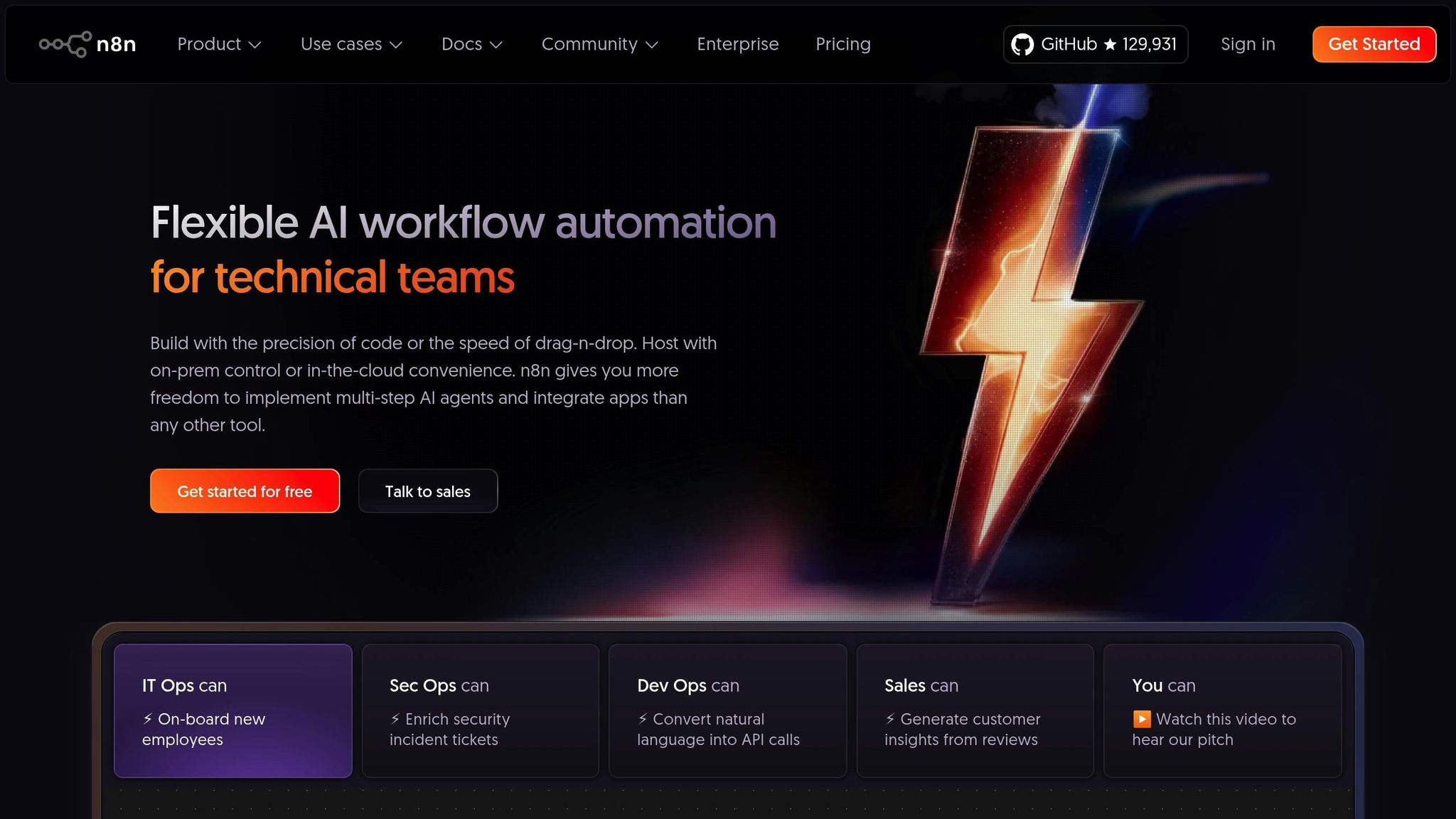
n8n is an open-source platform designed for secure and independent automation. Unlike cloud-only tools, n8n can be self-hosted, making it a great option for businesses that prioritize data privacy or want to avoid being tied to a specific vendor. Its visual node editor simplifies the process of creating workflows, making it accessible even for those without technical expertise.
Integration Capabilities with Other Tools
n8n connects seamlessly with popular tools like Slack, Google Workspace, Salesforce, and HubSpot. One of its standout features is the HTTP Request node, which allows you to link to virtually any service with an API - even when a pre-built integration isn’t available.
The platform is particularly strong in webhook handling and API management, making it a favorite among developers who need custom integrations. With n8n, you can trigger workflows from external systems, process incoming data, and send responses back, all within a single, streamlined setup.
For database tasks, n8n supports MySQL, PostgreSQL, MongoDB, and Redis natively. This means you can perform actions like reading, writing, and updating records directly within your workflows, often eliminating the need for additional database management tools.
These features make n8n a solid choice for businesses looking for scalable and adaptable automation solutions.
Scalability for Growing Businesses
n8n’s self-hosted architecture gives you the freedom to scale without being limited by external service quotas or pricing plans. As long as your infrastructure can handle it, you can run as many workflows as needed.
It also supports queue-based execution, which helps manage system resources during high-demand periods. Failed workflows automatically requeue, ensuring that even large volumes of operations are processed reliably.
For teams, n8n includes features like user management and credential sharing, making it easier to collaborate while securely managing sensitive information such as API keys. The execution history feature provides detailed logs, which are invaluable for troubleshooting and monitoring performance as your workflows grow more complex.
Customizability for Unique Workflows
n8n shines when it comes to creating custom workflows. With JavaScript code nodes, you can add custom logic to your automation, enabling complex data transformations, calculations, or integrations that go beyond what pre-built nodes can handle.
The platform also supports conditional routing and data filtering, allowing workflows to branch or merge based on specific criteria. This flexibility is perfect for managing diverse business needs.
Additional features include cron expressions for precise scheduling, webhook triggers for real-time automation, and manual execution for on-demand tasks. You can even create error-handling workflows that notify your team or take corrective actions when something goes wrong.
Pricing and Cost-Effectiveness
n8n provides a free self-hosted option with no restrictions on workflows, executions, or integrations, making it a budget-friendly choice for businesses that have the technical expertise to manage their own infrastructure.
For those who prefer a managed solution, n8n Cloud offers tiered pricing plans with benefits like automatic updates, backups, and technical support. For high-volume users, the self-hosted option often proves more economical, as it avoids the recurring costs associated with fully managed cloud platforms.
4. Relay

Relay is an automation platform designed to be both powerful and straightforward, making it a great option for professionals without a technical background. Its clean, intuitive interface allows users to create workflows without needing advanced coding skills, offering a practical solution for businesses that need automation without the complexity of traditional tools.
Integration Capabilities with Other Tools
Relay connects seamlessly with over 100 different apps, and its library of integrations keeps growing every month. These integrations are crafted to be intuitive and flexible, focusing on ease of use while maintaining high functionality. For more advanced users, Relay also supports Webhooks and HTTP Requests, enabling connections with a wide range of API-driven services. This flexibility ensures businesses can link Relay to the tools they rely on most.
Customizability for Unique Workflows
Relay doesn’t just stop at integrations - it also makes it easy to customize workflows to fit unique business needs. For example, Lucas Grey shared his experience:
"Falling in love with @relay. Tried make and zapier and this uiux worked the simplest. It gets the job done. Automated our waitlist collection and replying process. Used gpt in the workflow to parse the replies to our waitlist email qtns & saved them into our notion database." - Lucas Grey, @ImLucasGrey
This level of flexibility allows users to create workflows that address specific challenges, making it a practical tool for a variety of industries.
Scalability for Growing Businesses
As your business grows, Relay’s expanding ecosystem ensures it can scale alongside your needs. Whether you're a small business or an enterprise, Relay offers the tools to keep your workflows efficient and adaptable.
5. Integrately
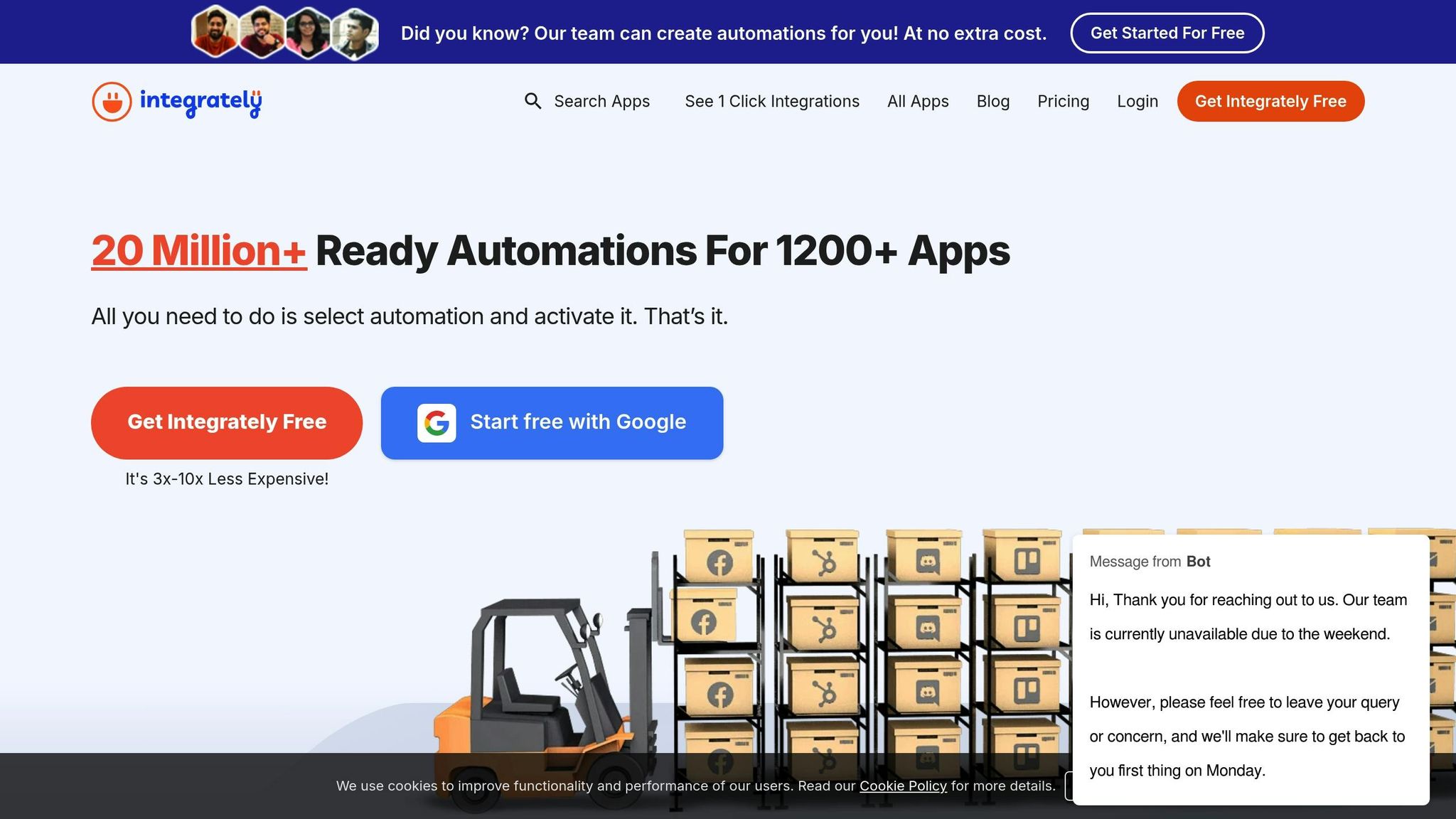
Integrately is an automation platform designed to cater to businesses of all sizes. It stands out for its straightforward interface, making it a great choice for teams looking to simplify their processes without diving into complex setups. Here’s a closer look at how Integrately supports integrations, affordability, customization, and business growth.
Integration Capabilities with Other Tools
Integrately connects with over 1,000 apps, covering CRMs, email marketing tools, e-commerce platforms, and project management software. What sets it apart is its library of pre-built "1-click" automations tailored for common use cases.
These pre-made workflows let users quickly link popular tools like Shopify, Mailchimp, Google Sheets, and Slack, eliminating the need to start from scratch. For businesses with more specific needs, Integrately also supports webhook integrations and API connections, offering tech-savvy users the flexibility to connect virtually any web-based service.
Pricing and Accessibility
Integrately’s pricing is designed to be approachable, especially for small and medium-sized businesses. It includes a free tier, giving startups and solo entrepreneurs an opportunity to explore automation without any initial investment.
Paid plans are competitively priced and based on the number of tasks processed each month, rather than the number of integrations. This structure is particularly appealing for businesses running multiple simple workflows, as they can scale their automation efforts without worrying about extra costs for each connection.
Tailored Workflows for Unique Needs
The platform allows users to tweak its pre-built templates using conditional logic, filters, and multi-step workflows. Features such as data formatting, field mapping, and action delays provide additional flexibility.
With its visual workflow builder, users can easily map out how data moves between apps and even test their automations before launching them. This user-friendly approach saves time and ensures workflows align perfectly with business requirements.
Supporting Business Growth
As businesses grow, Integrately’s task-based pricing model makes scaling seamless. Teams can start with basic automations and gradually incorporate more advanced workflows as their operations expand. The platform adapts to increased task volumes, allowing companies to upgrade plans as needed.
6. IFTTT
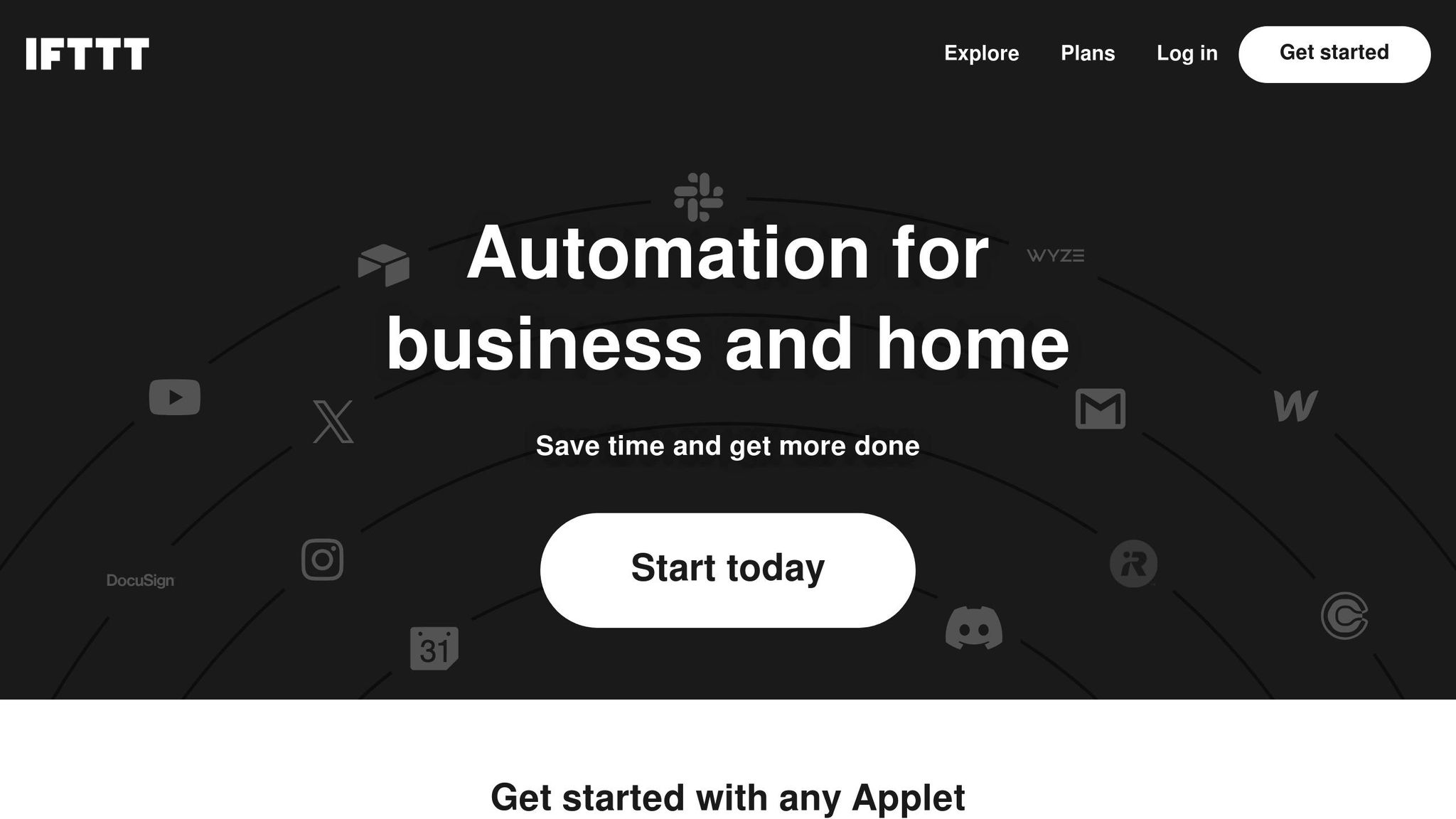
IFTTT (If This Then That) is a platform that simplifies automation using a basic trigger-action setup. It’s particularly useful for small businesses and entrepreneurs who need easy-to-implement solutions to streamline their daily tasks. By connecting apps, smart devices, and business tools, IFTTT bridges the gap between personal and professional workflows.
Integration Capabilities with Other Tools
IFTTT works seamlessly with a wide variety of services, including popular business tools like Google Workspace, Slack, and Trello. It also connects with smart devices, social media platforms, and IoT sensors, making it versatile for both personal and business use.
The platform relies on "applets", which are pre-designed automations based on simple if-this-then-that logic. For instance, you can set up tasks like saving Gmail attachments directly to your cloud storage, cross-posting images across social platforms, or receiving alerts when your company is mentioned online. Developers can also use webhooks to integrate custom applications, adding even more flexibility.
This broad compatibility allows businesses to create efficient, cost-effective automations that ensure information flows effortlessly across their tools and systems.
Pricing and Cost-Effectiveness
IFTTT uses a freemium model, making it accessible for users with limited budgets. Free accounts offer basic functionality, while paid plans unlock advanced features like conditional logic and faster execution times. Higher-tier subscriptions often include perks like priority support and better filtering options.
This flexible pricing structure makes IFTTT an affordable choice for businesses looking to implement straightforward, dependable workflows without the expense of more complex enterprise solutions.
Customizability for Unique Workflows
While IFTTT is known for its simplicity, it also provides customization options to meet specific needs. Users can tweak applets by modifying triggers, filters, and action parameters to better align with their workflows.
The platform supports conditional statements and filters, enabling more advanced automations. For example, you can create applets that only activate during certain hours or process emails that contain specific keywords. For businesses with unique needs, IFTTT’s Developer Platform allows the creation of custom services and applets, making it easier to integrate proprietary tools with widely used applications.
Scalability for Growing Businesses
IFTTT is built to grow alongside your business. As companies adopt more tools, they can easily add new applets to keep their systems interconnected and their workflows running smoothly.
For businesses just starting with automation, IFTTT serves as a user-friendly entry point. Teams can begin with simple tasks and gradually build more complex strategies as they become more comfortable with the platform. Its intuitive design means employees can create automations without heavy reliance on IT support.
Additionally, the mobile app allows users to manage and monitor automations from anywhere, ensuring critical workflows stay on track - even when working remotely or traveling. This flexibility makes IFTTT a practical solution for businesses of all sizes.
7. FlowForma
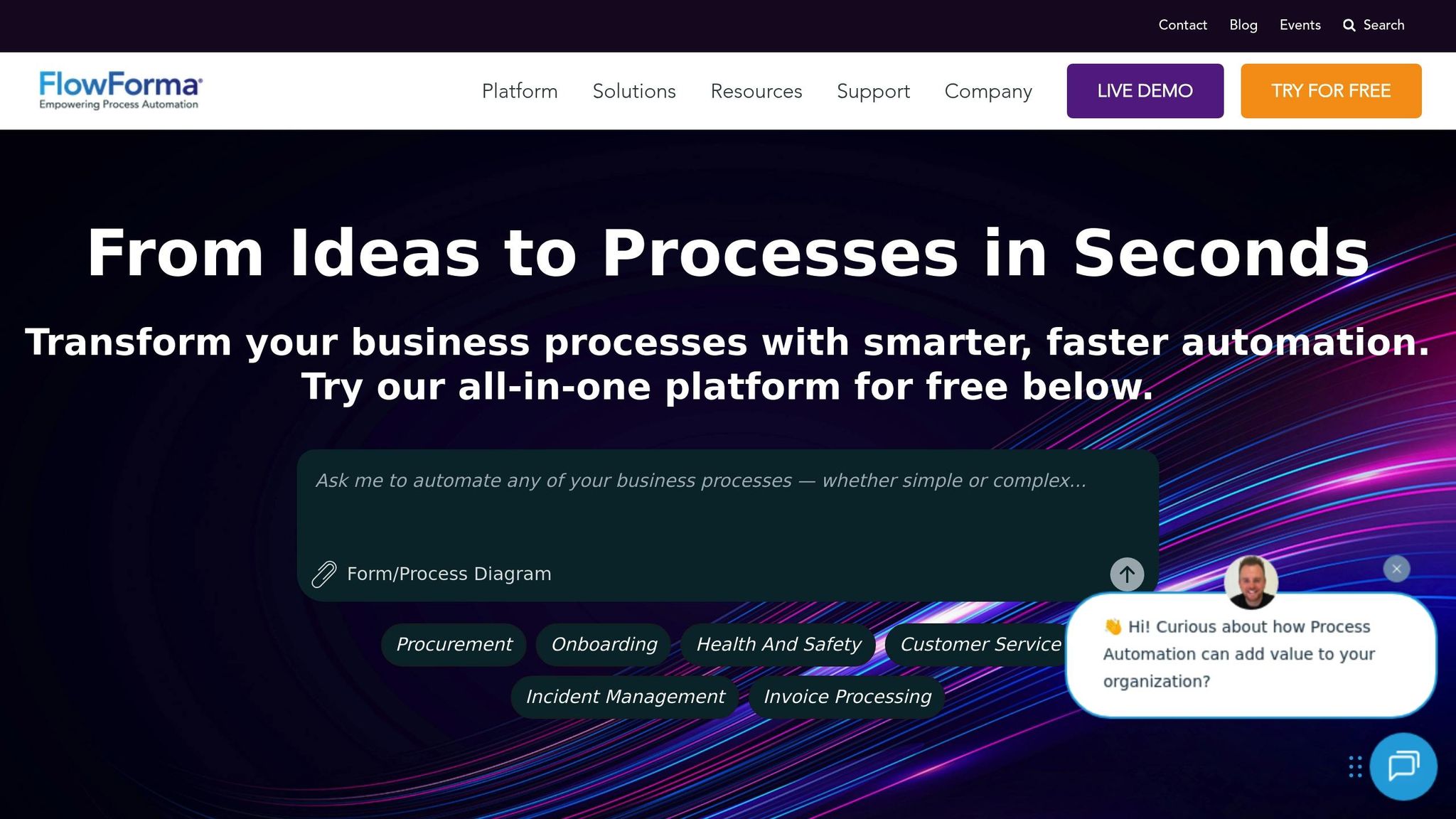
FlowForma is a no-code business process automation platform powered by AI. It’s designed to help both technical and non-technical users create workflows with ease. By combining advanced automation features with an intuitive interface, FlowForma makes process creation accessible across teams, regardless of their technical expertise.
One standout feature is the AI-powered Copilot, which simplifies workflow creation. Users can interact with the system through conversational inputs or even upload images to design business processes in seconds. This streamlined approach allows busy teams to implement automation quickly, even under tight deadlines.
Integration Capabilities with Other Tools
FlowForma is built on a cloud-native Microsoft Azure foundation, which ensures strong integration capabilities. It supports seamless, bidirectional data exchange between FlowForma and other systems, making information flow effortlessly.
The platform offers three key integration methods:
- SQL Staging Database: A solution for storing and transferring master data across multiple systems.
- FlowForma No Code Web API: Communicates with over 10,000 commercial applications through REST or SOAP-based APIs, all without requiring coding skills.
- FlowForma Extensibility Framework: Allows users to create JavaScript-based extensions that interact directly with forms and UI widgets.
"Knowing that our customers wanted to connect FlowForma Process Automation to other apps they use, it was important for our team to develop seamless integration. This innovation now empowers our community to connect their business processes to over 1,000 apps, so the possibilities are completely endless from setting up triggers, to kicking-off processes with data from other apps or sending data from FlowForma Process Automation to your team's favorite applications." - Gerard Newman, CTO, FlowForma
One practical example of FlowForma’s integration power is its Procore integration, which is particularly useful in the construction industry. For instance, when a new submittal is created in Procore, FlowForma can automatically trigger custom workflows for document review and approval, involving both internal and external stakeholders. Once the process is complete, approved documents are updated directly back into Procore, creating a seamless loop. FlowForma also integrates with other construction tools like Viewpoint Spectrum, Autodesk BIM 360, QuickBooks, ARES PRISM, and Aconex.
These options provide businesses with the flexibility to design workflows tailored to their needs.
Customizability for Unique Workflows
FlowForma’s drag-and-drop builder allows users to create a wide range of workflows, from simple approvals to complex, multi-step processes with conditional logic and automated notifications.
A particularly innovative feature is the Ambient Process Discovery Agent, which can transform meeting conversations into ready-to-use workflows. This tool captures process details as they are discussed, bridging the gap between brainstorming and implementation.
The platform also offers pre-built templates tailored for industries like healthcare, finance, and manufacturing. These templates serve as a great starting point, allowing teams to quickly adapt workflows to their specific needs.
"The speed of development and the opportunity to involve process owners in creating their own FlowForma forms and workflows is a game-changer. The ability to create workflows quickly with governance from IT, without being reliant on them, is critical." - Head of Digital Identity, Blackpool Teaching Hospital NHS
Scalability for Growing Businesses
FlowForma is designed to grow alongside your business. Its architecture supports scalable workflow replication and modification, making it easy to expand successful processes across different departments or locations.
The platform strikes a balance between empowering users and maintaining IT oversight. Business users can independently create and test workflows in controlled environments, while IT teams retain governance to prevent bottlenecks and ensure compliance.
"At FlowForma we are constantly working on ways to develop our product further and enhance the user experience for our customer base. Providing easy-to-use, pre-built integration into applications such as Procore makes it easier for construction companies to automate their processes at scale, drive efficiency, and connect multiple systems. As the number of applications in use in construction companies continues to grow, we will continue to provide 'out of the box' no code integration to our construction customers." - Gerard Newman, Chief Technology Officer, FlowForma
8. Automation Anywhere
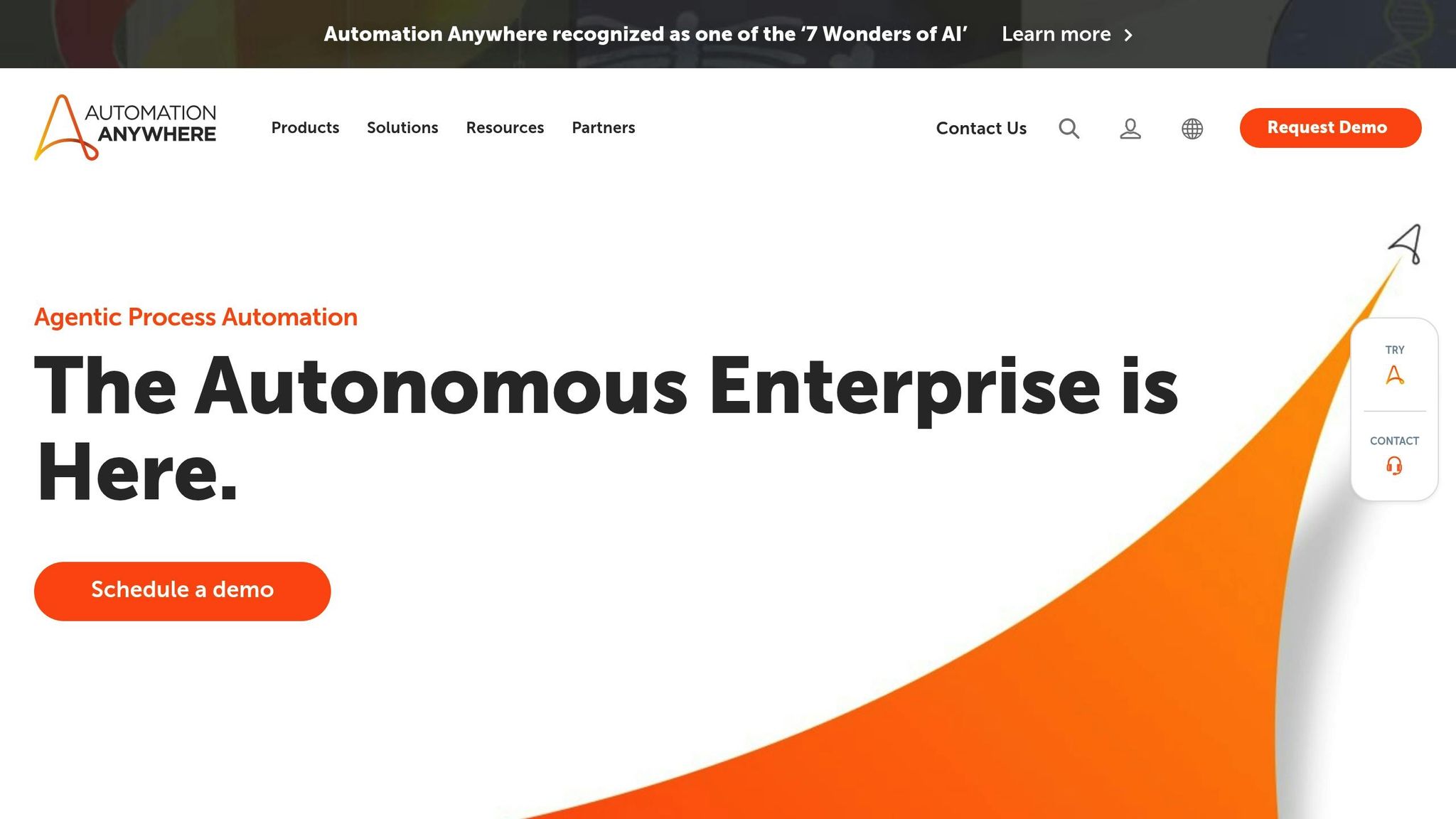
Automation Anywhere is a robust RPA (Robotic Process Automation) platform designed for enterprise-level needs, blending traditional automation with AI to tackle both straightforward and complex tasks. It stands out for its cloud-native design and its ability to handle a wide range of automation scenarios, from simple data entry to intricate workflows spanning multiple systems.
One of the platform's key strengths is its flexibility. It supports both attended and unattended automation, meaning bots can either assist employees in real-time or work independently in the background. This makes it a versatile tool for businesses aiming to streamline operations while maintaining efficiency.
A standout feature is its AI-powered Document Automation, which can process unstructured data from documents like invoices, contracts, and forms. This capability is particularly beneficial for teams in finance and procurement that deal with large volumes of paperwork.
Scalability for Expanding Operations
Automation Anywhere is built to grow with your business. Thanks to its cloud-first architecture, the platform can scale effortlessly, adjusting bot capacity based on demand. Whether workloads spike or slow down, the system ensures resources are used efficiently. The centralized Control Room simplifies management across departments, while elastic scaling handles fluctuations seamlessly.
Additionally, it empowers non-technical users through citizen developer programs. Using pre-built templates and an intuitive drag-and-drop interface, business users can create their own automations, reducing the burden on IT teams and accelerating automation efforts.
Seamless Integration with Other Tools
Integration is another area where Automation Anywhere shines. Its Bot Store offers a wide selection of pre-built bots and connectors for popular tools like Salesforce, SAP, Microsoft Office 365, and Google Workspace. The platform's API-first design ensures smooth connectivity with both modern cloud applications and older legacy systems.
For database operations, Automation Anywhere supports major systems such as Oracle, SQL Server, and MySQL, enabling bots to perform tasks like reading, writing, and updating records across platforms. Its comprehensive API framework also allows integration with other RPA and workflow tools, giving businesses the flexibility to maximize their existing technology investments while avoiding vendor lock-in.
Tailored Customization for Unique Needs
Automation Anywhere provides development environments suited to various skill levels. Business users can leverage the visual, drag-and-drop Bot Editor, while technical developers can take advantage of the Enterprise Client's advanced scripting capabilities. The IQ Bot adds another layer of customization, as it can be trained to process industry-specific documents, making it adaptable to specialized tasks.
The platform also supports conditional logic and exception handling, enabling bots to make decisions in real-time and handle unexpected situations effectively. Collaboration features, such as version control, allow multiple developers to work on the same project while maintaining compliance and tracking changes.
Flexible Pricing and Value
Automation Anywhere offers usage-based pricing, with tiered licensing options for both development and operational needs. Its analytics tools provide insights into the time saved and errors reduced, helping businesses measure the return on their automation investments. For larger enterprises, custom licensing agreements are available, offering scalable solutions and dedicated support tailored to their specific requirements.
9. Workato
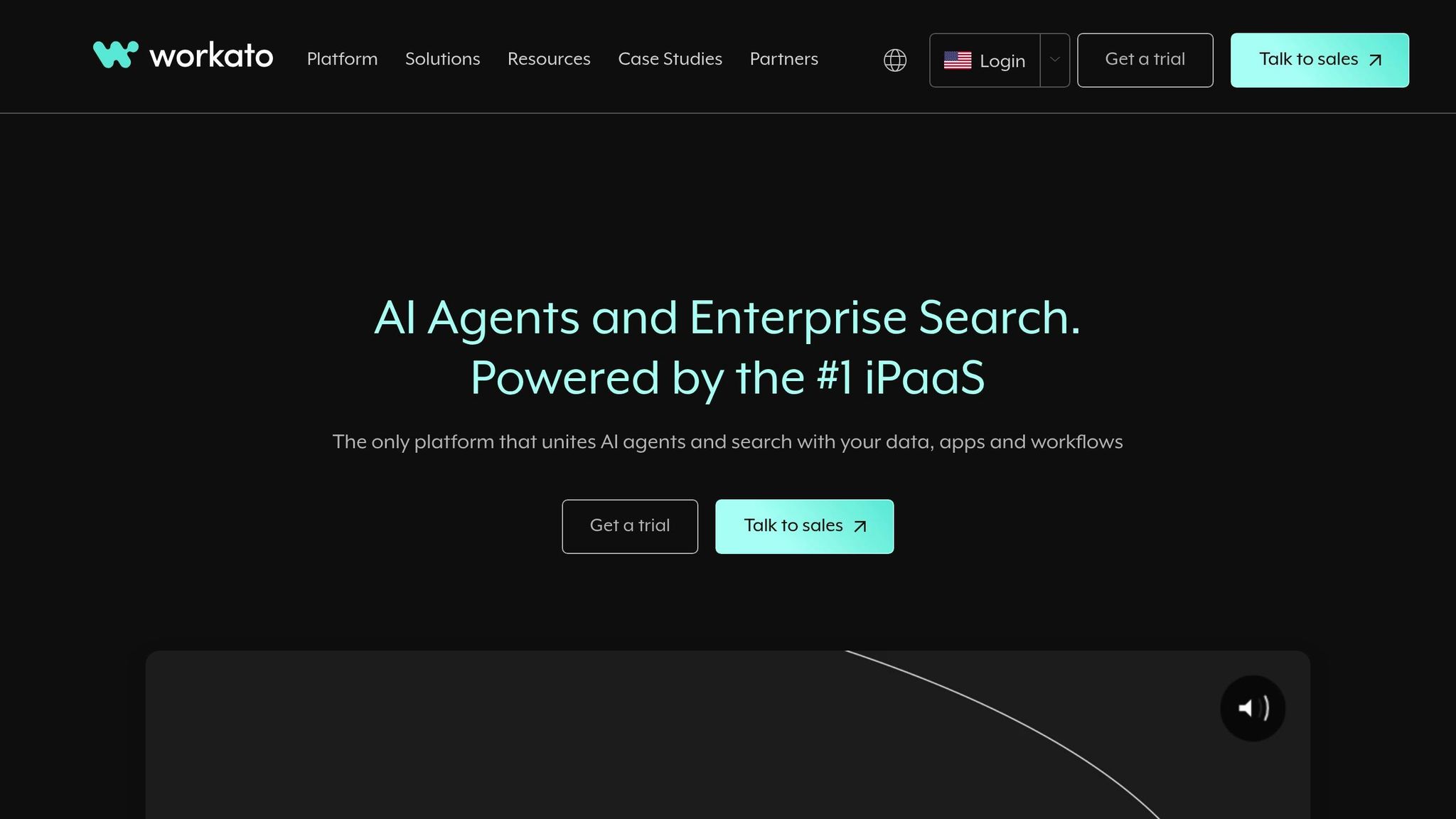
Workato is an enterprise automation platform designed to deliver scalable solutions for mid-sized and large organizations. Unlike traditional integration tools, Workato uses a recipe-based system that allows users to create automated workflows spanning multiple applications and systems with ease.
The platform shines through its intelligent automation engine, which handles everything from simple data transfers to complex processes. Whether it's real-time updates or batch processing, Workato enables businesses to automate tasks like lead routing in CRM systems or financial reconciliations across departments.
What makes Workato stand out is its combination of a user-friendly interface and advanced developer tools. Non-technical users can create automations using pre-built connectors and templates, while IT teams can tap into features like custom connectors, JavaScript functions, and API management tools. This recipe-based approach offers a balance of simplicity and power, making it a strong choice for modern enterprises.
Scalability for Growing Businesses
Workato’s cloud-native, multi-tenant architecture is built to scale effortlessly. It supports segmentation by department, region, or business unit, all while maintaining centralized governance. This flexibility allows businesses to start with specific use cases and expand automation across the organization without running into architectural limitations.
For growing companies, Workato offers workspace management tools that support separate environments for development, testing, and production. This ensures that any changes to automations are thoroughly tested before going live, minimizing the risk of disruptions as the business scales.
Integration Capabilities with Other Tools
Workato boasts an extensive library of pre-built integrations, which are regularly updated to include tools like Salesforce, NetSuite, Workday, ServiceNow, and Microsoft Dynamics.
The platform is particularly effective in hybrid integration scenarios, seamlessly connecting cloud-based applications with on-premises systems through secure agent technology. This is especially useful for organizations that rely on legacy systems while adopting modern cloud tools.
Beyond basic data transfers, Workato supports advanced integration patterns like event-driven architectures and real-time data synchronization. It also handles a variety of data formats - JSON, XML, CSV, and EDI - making it adaptable to a wide range of integration needs.
Customizability for Unique Workflows
Workato’s flexibility extends to its ability to meet specific business needs. Its visual recipe builder, equipped with drag-and-drop functionality, allows business users to create workflows without coding. For more advanced requirements, technical users can write custom JavaScript code to handle complex data transformations and business logic.
The platform’s conditional logic engine enables detailed workflow branching, perfect for managing complex approvals or exception handling. Built-in error management and retry mechanisms further enhance the reliability of automated processes.
For businesses with unique integration requirements, Workato provides a custom connector framework. Developers can use the platform’s SDK to build proprietary integrations, ensuring even specialized systems can be incorporated into automated workflows.
Pricing and Cost-Effectiveness
Workato uses a task-based pricing model, which allows organizations to pay based on the number of executed tasks rather than per user or connector. This approach can be particularly cost-efficient for businesses handling a high volume of automation while keeping the number of users managing workflows relatively small.
The platform offers tiered plans, from professional packages for smaller implementations to enterprise options that include features like custom connectors, dedicated support, and enhanced security controls. Enterprise customers can also negotiate custom pricing tailored to their specific needs.
10. Windmill
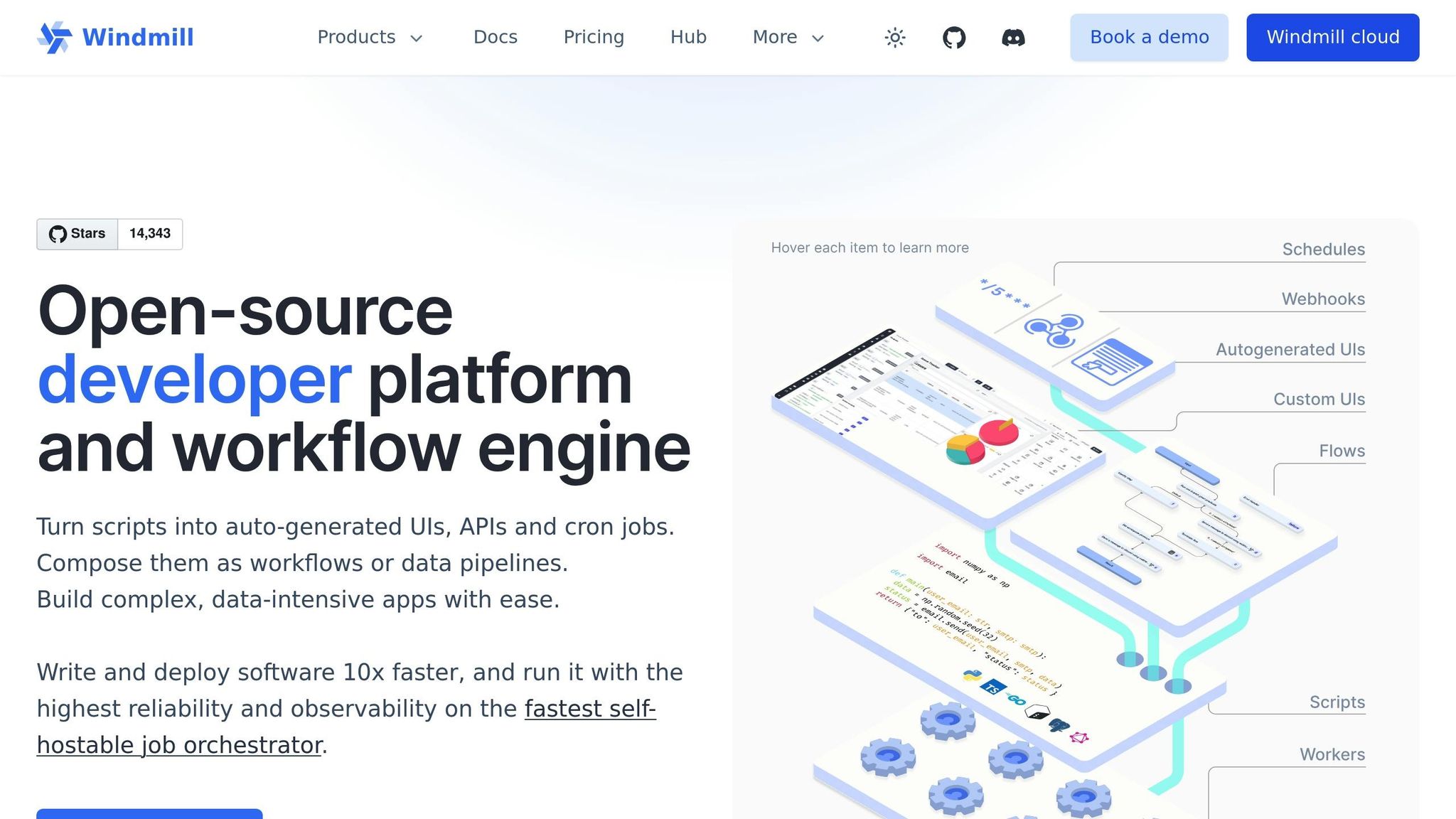
Windmill is an open-source platform designed for workflow automation. It allows organizations to turn individual scripts into fully functional workflows ready for production. It caters to both technical teams - who can implement specific business logic - and non-technical users, who benefit from automatically generated, user-friendly interfaces.
Built for Business Growth
Windmill's architecture is designed to handle increasing workloads efficiently. It supports horizontal scaling and multi-tenancy, making it easier for businesses to grow without performance issues. Plus, integration with version control systems ensures teams can monitor and manage changes to workflows with ease.
Seamless Integrations
With its flexible API connections and webhook triggers, Windmill integrates smoothly with external databases, cloud services, and other applications. This setup enables real-time data processing and keeps workflows connected across platforms.
Tailored Workflows Made Simple
Windmill stands out with its script-first approach, allowing users to add custom logic and conditional flows to workflows. This level of customization makes it possible to create workflows tailored to unique business needs while maintaining simple and accessible interfaces.
Flexible Pricing and Deployment
Windmill uses a resource-based pricing model, including a free tier for those just getting started. As an open-source platform, it also offers self-hosting options, giving organizations the flexibility to deploy it in a way that best suits their needs.
Tool Comparison Chart
Here's a quick way to recap the features we've gone over: consider scalability, integration options, customization potential, pricing, and how well each tool aligns with your specific needs. For the most accurate and up-to-date details, make sure to visit each provider's official website or reach out to them directly.
Conclusion
Streamlining workflows is a game-changer for boosting business efficiency and driving growth. The right workflow automation tool can turn disorganized manual processes into smooth, efficient systems. Whether it’s Zapier with its vast integrations, n8n offering open-source adaptability, or Automation Anywhere with its enterprise-level capabilities, each tool brings something different to the table.
When selecting a tool, think about your business size, technical expertise, integration needs, and future goals. As highlighted in the tool comparison chart, aligning your automation strategy with your unique requirements is critical.
Scalability is another key factor - your chosen tool should grow alongside your business. Keep in mind the learning curve and setup time for each platform. For instance, while Automation Anywhere offers robust features, it may require training. On the other hand, simpler tools like IFTTT are faster to implement but might not meet long-term demands.
Automation pays off quickly by freeing your team from repetitive tasks, allowing them to focus on initiatives that fuel growth.
Start small. Test automation with a pilot project in one department, track the results, and fine-tune your approach before rolling it out company-wide. This step-by-step process reduces risks and provides valuable insights to help you integrate automation seamlessly into your operations.
FAQs
What should I consider when choosing a workflow automation tool for my business?
When picking a workflow automation tool for your business, the first step is to pinpoint your specific needs and objectives. Think about factors such as how user-friendly the tool is, whether it can grow with your business, and how smoothly it connects with the systems you already use. It's also worth exploring tools that allow for customization, ensuring they fit seamlessly into your current workflows while supporting future expansion.
Another important aspect to consider is whether the tool offers robust insights and reporting features. These can be invaluable for tracking performance and identifying areas to boost efficiency. Ultimately, selecting a solution that aligns with your business's complexity and long-term vision will help you maximize its value as your operations expand.
What should I consider when scaling workflow automation tools for my growing business?
When expanding workflow automation tools for your business, focus on solutions that can adapt to your evolving needs. Begin by pinpointing repetitive tasks that can be automated without interrupting daily operations. Look for tools like no-code platforms or AI-driven systems that can handle more complexity and workload as your business grows.
Take the time to map out your workflows and start testing automation on a smaller scale before applying it throughout your organization. This step-by-step approach helps ensure a smoother transition and makes it easier to fine-tune processes for better efficiency. Gradual scaling allows you to create a solid system that aligns with your business growth.
Can workflow automation tools work with both older systems and modern cloud-based applications?
Yes, by 2025, most workflow automation tools are built to work effortlessly with both older legacy systems and modern cloud-based applications. They leverage APIs and open protocols to ensure smooth communication between platforms, enabling workflows to function efficiently across various environments.
This capability helps businesses connect outdated infrastructure with newer technology, allowing them to automate processes without needing to completely replace their current systems.

